Alpha Centauri is, as you know, currently the closest star system to the Solar System. It is a triple star system, comprising Alpha Centauri A (a G2 V star slightly brighter and slightly more massive than the Sun), Alpha Centauri B (a K1 V slightly dimmer and slightly less massive than the Sun), and Alpha Centauri C (a low-mass, dim red dwarf which is also known as Proxima Centauri).
Proxima is strongly believed to be orbited by a world in the habitable zone. According to Wagner, K., Boehle, A., Pathak, P. et al1 in Imaging low-mass planets within the habitable zone of α Centauri, Alpha Centauri A may also boast a world in its habitable zone.
To quote:
In other words, C1 is not a known systematic artifact, and is consistent with being either a Neptune-to-Saturn-sized planet or an exozodiacal dust disk.
Admittedly, this does not narrow down the nature of C1 as narrowly as one would like. And the low end of the size estimate is still not exactly Earth Two. Still, the paper does not rule other, perhaps more Terrestrial worlds in the Alpha Centauri A system’s Goldilocks Zone. Or conveniently sized moons orbiting C1. After all, the Moon is roughly one percent the mass of Earth and Charon is a mighty ten percent of the mass of Pluto. In any case, it’s interesting to see yet another “Here there may be dragons” area on our maps beginning to be sketched in with actual data.
Not only is Alpha Centauri the nearest system to ours, two of its three stars are at least somewhat sunlike. Unsurprisingly, science fiction long ago saw the narrative potential offered by Alpha Centauri. Consider these five examples.
Alpha Centauri or Die! by Leigh Bracket (1963)
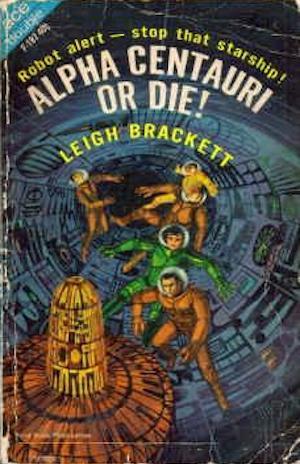
The Solar System is firmly under the thumb of an authoritarian government determined to bring peace with a stomping boot. While every reasonable need is filled, daily life is regimented and the space lanes are plied solely by robot ships. Not everyone is happy with this arrangement. The malcontents include among them men like Kirby—men with the skills to crew a one-way flight to Alpha Centauri and its known habitable world.
There are, of course, one or two catches. The State forbids such flights. The same robot ships that travel between the solar planets could follow the refugees to Alpha Centauri. Most importantly, there is a reason the Solar System’s authoritarian have never tried to annex Alpha Centauri. Alpha Centauri’s world may not be home to someone but it is definitely home to something. How it will react to invaders remains to be seen….
***
Flight of Exiles by Ben Bova (1972)

Half a century after fleeing Earth, the retrofitted space station-turned-unnamed generation ship approaches Alpha Centauri. The original scientists who set out on this journey knew that the system had a planet that might be habitable. Their children discover a world more habitable than most of the worlds back in the Solar System, but one that (alas!) falls far short of Earth itself. Surface gravity is a third higher than Earth’s and the atmosphere has dangerously high levels of nitric oxides and sulfur oxides.
The ship has two equally unsatisfactory options. The refugees could simply continue on their way, hoping to reach a world more to their taste before their ship falls apart. Alternatively, they could use their prodigious biotechnical skills to create beings adapted to Alpha Centauri’s world. If they do, will they see such creations as their children? That’s an open question.
There is not much time to decide. At least one crewmember is willing to kill to ensure the ship makes the correct choice.
***
The Phoenix Legacy by M. K. Wren (1981)
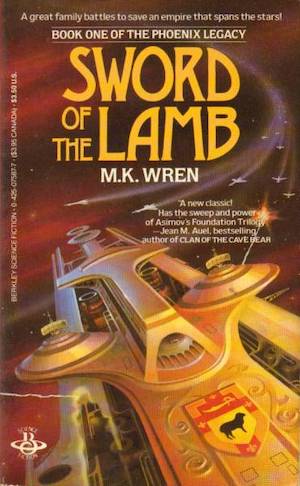
(Sword of the Lamb, Shadow of the Swan, and House of the Wolf)
The civilization that rose out of the ruins of ours is wealthy and technically advanced. Thus, the worlds of the Concord include not just the worlds of our Solar System, but also Alpha Centauri A’s Pollux and Castor (the first of which is habitable). The catch is that the Concord is a caste-ridden society which generates wealth for thousands of Elites at the cost of misery for billions of Bonds.
Some Elite admit this is unjust. They are, however, painfully aware that the last attempt to reform society ended in a civil war that killed a billion people. How to reform the system without losing privilege, and without risk? It’s quite the puzzler. But the clock is ticking for the Concord, because the rebel Phoenix has technology the Concord lacks and is determined to free the Bonds.
***
Voyage from Yesteryear by James P. Hogan (1982)
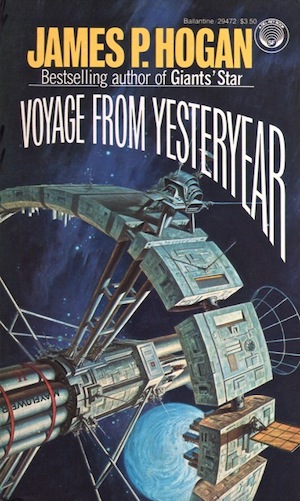
Determined to ensure that humanity survives the nuclear war that is sure to come, North American Space Development Organization and its Asian partners send off the SP3 interstellar probe. The probe carries with it encoded genetic information and machines designed to create and raise human children. The gamble pays off in spades: not only are humans established on Alpha Centauri A’s garden world Chiron, but the venture also founds a post-scarcity utopia.
Back on Earth, humanity digs out from the radioactive rubble and rebuilds civilization. North America’s New Order provides Americans with a firm guiding hand and freedom from democratic excesses. The New Order covets Chiron. To prevent its Terrestrial rivals from conquering Chiron first, the Americans dispatch a crewed starship on a generation-long mission.
And if the Chironians object? The New Order knows how to crush dissent.
***
Encounter With Tiber by John Barnes and Buzz Aldrin (1996)
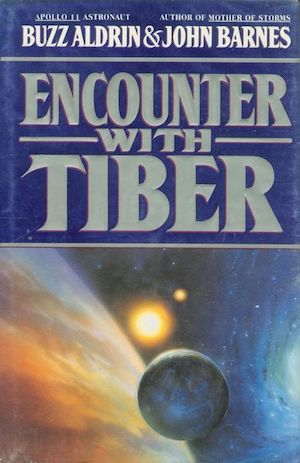
In this collaboration between Barnes and former astronaut Aldrin, the once verdant garden world humans call Tiber is a moon of a gas giant orbiting Alpha Centauri A. When the human starship Tenacity launches towards Tiber in 2069, it does so with reasonable confidence that Tiber once was life-bearing. After all, the Solar System received a message from Tiber.
In fact, Tiberians met humans long before humans mastered the art of interstellar flight. When the first Tiberian expeditions reached the Solar System in the 73rd century B.C., humans lived in Stone Age tribes. The Earth and its inhabitants were ideal from the Tiberian perspective. Stone age Terrestrials could hardly prevent the Tiberians from taking the Earth for their desperately needed new home. Victory is assured!
And yet, the fact that Earth is not and has never been a Tiberian colony suggests that something did confound the aliens. The answer to this mystery is revealed in surviving Tiberian documents….
***
Obviously, five books represent only a very small fraction of the books that have been written using Alpha Centauri A as a setting or destination. Feel free to make the case for your favourites in the comments below.
In the words of Wikipedia editor TexasAndroid, prolific book reviewer and perennial Darwin Award nominee James Davis Nicoll is of “questionable notability.” His work has appeared in Publishers Weekly and Romantic Times as well as on his own websites, James Nicoll Reviews and Young People Read Old SFF(where he is assisted by editor Karen Lofstrom and web person Adrienne L. Travis). He is a four-time finalist for the Best Fan Writer Hugo Award and is surprisingly flammable.
[1]Included in the et al: K. Wagner, A. Boehle, P. Pathak, M. Kasper, R. Arsenault, G. Jakob, U. Käufl, S. Leveratto, A.-L. Maire, E. Pantin, R. Siebenmorgen, G. Zins, O. Absil, N. Ageorges, D. Apai, A. Carlotti, É. Choquet, C. Delacroix, K. Dohlen, P. Duhoux, P. Forsberg, E. Fuenteseca, S. Gutruf, O. Guyon, E. Huby, D. Kampf, M. Karlsson, P. Kervella, J.-P. Kirchbauer, P. Klupar, J. Kolb, D. Mawet, M. N’Diaye, G. Orban de Xivry, S. P. Quanz, A. Reutlinger, G. Ruane, M. Riquelme, C. Soenke, M. Sterzik, A. Vigan & T. de Zeeuw.










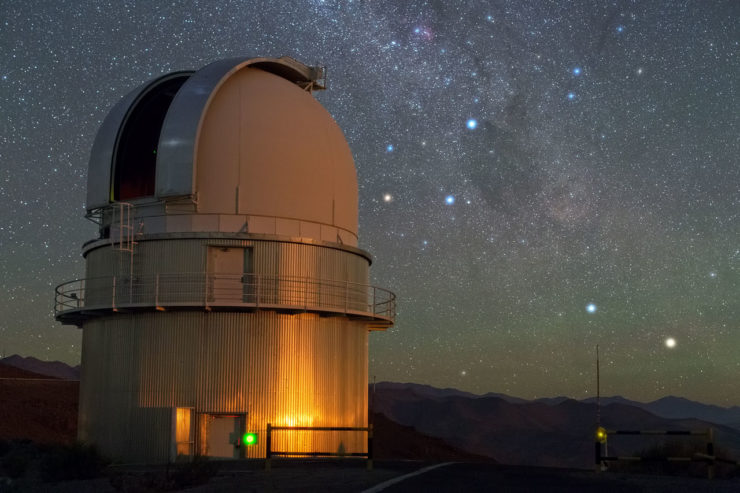
SO many of my friends and family are sci-fi fans and yet among them I was apparently the only one who ever read The Phoenix Legacy trilogy. Before I could do things like google titles I thought I was going nuts for a while because none of those avid readers even seemed to have heard of it.
Alpha Centauri was, of course, the intended destination of Lost in Space‘s interstellar caravan, Jupiter 2, before Doctor Smith’s shenanigans threw it off course.
And Far Centaurus was the destination of the generation ship in Heinlein’s Orphans of the Sky.
And let’s not forget this bit of classic dialog:-
FELLINI: What is that? Is that a uniform of some kind?
KIRK: This little thing? Just something I slipped on.
FELLINI: Kirk, maybe you don’t realise how serious this is. Sabotage of a government installation—
KIRK: Did I sabotage anything?
FELLINI: No. We stopped you in time. But what would you have done if we hadn’t found you?
KIRK: Believe me, Colonel, nothing at all.
FELLINI: Is that what you’re here for? Nothing at all?
KIRK: That’s what would have happened if you hadn’t interfered.
FELLINI: All right, Kirk. Maybe this will make you laugh. Sabotage! Espionage! Unauthorised entry! Burglary! How are those for starters? And I can think up lots more if you don’t start talking.
KIRK: All right, Colonel. The truth is, I’m a little green man from Alpha Centauri. A beautiful place. You ought to see it.
FELLINI: I am going to lock you up for two hundred years!
KIRK: That ought to be … just about right.
One of my favorite “Alpha Centauri” stories wasn’t a book at all, it’s “Sid Meyer’s Alpha Centauri” from 1999. Not only was it a great Civilizations-style explore-and-conquest game, the backstory behind the planet and the overall story arcs for the various possible protagonists were tons of fun.
And, yes, Zefram Cochrane, inventor of Star Trek’s warp drive, is from Alpha Centauri.
Sorry, wrong thread.
The sci-fi story about Alpha Centauri that always comes to mind for me is the 2013 novel Voyage to Alpha Centauri by Michael O’Brien. I wouldn’t call it a good book, as it’s far too long and overstuffed with pretentious asides about politics and religion, but the premise is so crazy that it’s stuck with me. When Earth’s first starship (a giant cruise liner filled with elites who are all naturally horrible people) arrives at Alpha Centauri, they find a planet covered with ruins of a savage culture that turns out to be a group of blood-drinking, child-sacrificing antediluvians who were inspired by the Devil to build a starship ark to escape the Flood. (Good old Noah, inspired by God, only got to build a floating ark out of gopher wood!) When the modern Earth starship leaves Alpha Centauri for the return journey, it goes off course and there’s a plague on board or something, while a few people who chose to stay behind on Alpha Centauri build a Catholic paradise. It’s implied in the epilogue that all those terrible people on Earth wiped themselves out in the meantime with nuclear war, so the colony on Alpha Centauri is a new beginning for the human race. As I type out the plot summary, I’m strongly reminded of something that starts with Q….
@1: I read The Phoenix Legacy books back when they were new – the first one got a positive review in Asimovs’ magazine, so some other folks probably heard of it too, back then. But these days people think of the 1980s as long ago, just because it’s 40 years ago.
Van Vogt’s Far Centaurus also features a trip to Alpha Centaurus that finds unexpected things.
I’m surprised that you left out The Three-Body Problem. This post belongs to Trisolaris!
I don’t have a copy to hand but I remember this offered a detailed look at an imagined Alpha Centauri. It took the then-plausible stance that Proxima is not bound to Alpha Centauri. Turns out it is, despite distance and all the chances other stars have had to swat it away from the central pair.
In contrast, Lee Correy’s Starship Through Space peaks with its cover. Once one starts reading it, it is all downhill from there.
Wunderland was the first settled planet in Nivens Known Space, had a spot of bother with the Kzinti for a while…
Echoing #10 – the Three-Body Problem series is the first one I thought of, and I’m surprised it’s not on here (although it’s cool to see lesser-known, less recent works highlighted instead).
One big difference between 3BP and the works featured here, though, is that it doesn’t concern a voyage to Alpha Centauri, but an invasion from the system…
I don’t care for Three Body Problem, so I didn’t mention it.
In C. J. Cherryh’s Alliance–Union universe, there are passing references to an station/orbital colony at Alpha Centauri suffering a Roanoke-style vanishing.
@15: Pardon me while I climb on my hobbyhorse.
Do they mean “There is a clear record of where the colonists went, but departing one’s Holy and Most Righteous Way of Life in order to beg for help from Lower Orders of Humanity and slowly degenerate from helpless refugees to assimilated and respected members of the community of said Lower Orders is Simply Unthinkable?”
One of the first SF books I owned was from Scholastic Books, I think it cost a quarter; Revolt on Alpha C by Robert Silverberg. There were disabled rockets and spacewalks, dinosaurs, and a rebelling colony; everything a young reader would want.
Murray Leinster, “Proxima Centauri”, 1936. I read it in Before the Golden Age, vol, 3. “Crude” is generous. The convenient translator device is a minor aspect. The love of meat is odd. The climax and how it happens is … ludicrous even by 21st century standards.
@7 Wow, I had to look him up, and yes of course he has a Wikipedia page:
https://en.wikipedia.org/wiki/Michael_O'Brien_(Canadian_author)
First, I am shocked — shocked! — that you did not cite Robert Silverberg’s first “novel”, Revolt on Alpha C. (Which I read age 10 or so, and was not impressed by even then.)
Also, to nitpick a bit, Alpha Centauri or Die! is a fix-up of two earlier novellas by Brackett, “The Ark of Mars” and “Teleportress of Alpha C”, from Planet Stories (September 1953 and Winter 1954-1955, respectively.) I don’t THINK there were any significant changes. Thus the date is really 1954. It turns out that as far as Wikipedia is concerned, I’m the only person to have reviewed it! Until now!
Having mentioned Voyage to Alpha Centauri, I must also bring up The Sparrow and its sequel, Children of God, by Mary Doria Russell. These also treat a voyage to Alpha Centauri from a very Catholic perspective, but whereas O’Brien’s novel is more or less a polemic about how the modern world is going to hell, Russell’s novels are a more thoughtful exploration of the themes of exploration and discovery, colonialism and repression, and bodily integrity and consent through a sci-fi lens. They’re not overly long books, but they are – if you’re emotionally responsive while you read – devastating, and well worth reading.
The Fithp in Niven and Pournelle’s Footfall were from Alpha Centauri, right?
Not a book (and not even a regular magazine), but the DC hero Adam Strange teleports from Earth to a planet around Alpha Centauri for his original feats of derring-do. (As usual with comics heroes, he got spread around in later iterations.) I remember loving those back-of-the-book stories, and now I can’t remember why.
Count me in as also not liking the Three-Body series. Made it to about halfway through volume two before I stopped, asking myself why I’m was trying so hard to push through. And this was before I found out about the author’s political views.
I’m at a stage in life where there’s just far too many good things to read that I’ll probably never finish to bother with odious or offensive authors. I’m not in the “separate the author from the art” camp. And nostalgia is also very rarely a significant factor.
@17 @20 I remember that book! I remember nothing else about it but the title and a vague sense of revolution as being something that could be current, not just in the history books. Probably I was a bit young for it when I read it.
‘Doctor Who’ went as far as to ‘reproduce’ a being from Alpha Centauri…..
Alpha Centauri is also where our local planning department is situated, displaying planning charts of hyperspatial express routes and such. Useful to know for anyone who takes an interest in local affairs.
In the current Star Trek: Year Five comic, there’s a pandemic on Alpha Centauri.
@3/NomadUK: That dialogue sparked my love for Star Trek when I was eleven years old.
@24/Sunspear: What are the author’s political views? (I haven’t read the series nor do I intend to, I’m just curious.)
@Jana: well, he said some unfortunate things in support of China’s treatment of Uighur Muslims. Not sure I’m allowed to discuss that here.
I bought and read the Brackett when it came out, but I haven’t thought of it much since. I usually think of (and reread) Eric John Stark and think of The Long Tomorrow when she comes to mind. But the instant I spotted that insane tag line: “Robot alert…stop that starship!” the whole book came flooding back into memory. Good, but far from her best work.
@2 See also “Lost in Space: Voyage to the Bottom of the Soul,” a graphic novel by Bill Mumy and Thomas F. Zahler, in which the Jupiter 2 finally does make it to Proxima 4 in the Alpha Centauri system.
@17, @20 – Revolt on Alpha C has two further distinctions:
1. It was Silverberg’s first published book
2. It appears to be the first book of many to have a thinly-disguised Harlan (“Harl Ellison”) as a character.
20: Wikipedia snubs me again.
Let’s also not forget the “Terran Trade Authority” books, in which humanity’s interstellar First Contact was with two mutually hostile cultures on Alpha and Proxima Centauri, which led to us being dragged into their war.
Proxima and Ultima by Stephen Baxter.
I’m always surprised by how many I’d missed. The only one here I’ve read was Hogan’s Voyage From Yesteryear, which I enjoyed. Hogan often seemed to be riffing off an earlier classic and noted that he wrote his first book Inherit the Stars because he thought he could do a better job than Clarke’s 2001. Voyage from Yesteryear reminds me of “…and then there were none” by Eric Frank Russell (Astounding 1951) where a Terran spaceship lands on a cheerfully anarchist colony world and loses its crew to the wiles of MYOB!, possibly the most powerful sf acronym besides TANSTAAFL.
Another kid’s book (along with Revolt on Alpha C) that needs mentioning: the fourth of Paul Galdone’s “Space Cat” books, Space Cat and the Kittens, is about a voyage to Alpha Centauri where they find – surprise! – dinosaurs. I seem to recall (it’s been fifty years and more) that this was the weakest of the four books.
@36 — Nitpicking, but Paul Galdone was the illustrator of the Space Cat books, right? Ruthven Todd was the writer.
Babylon 5 posits that humanity’s first major extrasolar colony is on the third planet of Proxima Centauri, although due to confusion with the alien Centauri (whom they met in the Alpha Centauri system, but they weren’t from there) they eventually renamed it to just “Proxima.” It only appears once in the show, as the backdrop for a major space battle.
The Freespace video games also have a lot of action at Alpha Centauri. Amusingly, the Freespace universe uses subspace jump tunnels which link systems together with absolutely no regard for physical distance, so despite being the nearest system to Earth, it’s actually incredibly distant and a major pain in the backside to get to from Sol via the jump network. One flaw with this was that in the second game, Earth has been cut off from the rest of the jump network and nobody can communicate with it for over thirty years, but no-one even tries to send messages across physical space from Alpha Centauri to find out what’s going on (a good example of FTL becoming so pervasive that writers forget there’s other ways of doing things).